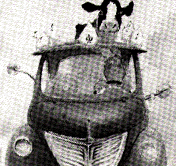






|
Watermelon Blue
H. Werner Zimmermann and the Colour of Spring
Volume 18 Number 3
Meet H. Werner Zimmermann, the artist and children's author illustrator with the sense of humour behind the new version of the gullible Henny Penny and friends, the befuddled, hard-working Farmer Joe, and the confused but energetic Alphonse. His favourite colour is watermelon blue -- and he's as comfortable sketching farm fowl in a German barnyard as he is working with Inuit printmakers in Povungnituk, Arctic Quebec, or planning a commissioned work for Air Canada's corporate collection. Werner Zimmermann is a versatile Canadian artist with a whimsical sense of humour who has recently turned a very talented hand to the writing and illustration of books for children. 
Collaboration with author Nancy Wilcox Richards as the illustrator of Farmer Joe's Hot Day and Farmer Joe Goes to the City, published by North Winds Press, was the artist's successful initiation into the children's literary scene. The popularity of this series led to publication of Zimmermann's version of the classic tale Henny Penny, also a North Winds Press publication, and the "Alphonse Knows" series, a collection of humorous stories designed to instruct as well as amuse young children. Published this year by Oxford University Press, the "Alphonse Knows" series teaches the basic concepts of colour, shape, numbers and seasons in The Colour of Spring A Circle is Not a Valentine, Zero is Not Enough and Twelve Months Make a Year. Born in Austria in 1951, Zimmermann moved with his family to Canada a year later. He notes wryly that one of the hazards of carrying a name like Heinrich Werner Zimmermann is that art and literary critics more often than not refer to him as a European artist, despite the fact that southern Ontario has been his home for much of his thirty-eight years. His childhood, though, was traditionally European, at times over protected, and travel was an unknown quantity. In reaction, he's become a self-proclaimed wanderer, with a strong sense that "there is the place that you come from, and then there is the place that you are" -- and the place that Werner Zimmermann is, more than even in his Guelph home, is in the Canadian north. Originally, Zimmermann didn't go to the north -- the north came to him. Early in his artistic career, he shared studio space with several other young artists. In the summer of 1977, a colleague was wrestling with the dilemma of choosing between a challenging Eskimo Arts Council project in Arctic Quebec and the stability of a teaching position in Ontario. Zimmermann went to the job interview with the arts council in his friend's place and shortly thereafter, he found himself "literally living in a Twin Otter" as he made his way to and from Nouveau (Arctic) Quebec in his capacity as Printmaking Resource Person to the Inuit printmakers in Povungnituk. He later served as travelling curator of "Things Made by Inuit," a collection of art and crafts that visited eleven Inuit communities in the winter of 1981. "Life in the north was wonderful, and it was hell. It really got under my skin," says Zimmermann, who was in and out of Arctic Quebec on a regular basis for seven years. What does a printmaking resource person do in Povungnituk? In this case, "technical advice, a lot of cajoling, dealing with the politics." But as far as Zimmermann is concerned, he took as much as he gave. He was profoundly impressed by the Inuit artists' connection with the land, as well as by the extraordinary beauty of the north, and he is quietly critical of government initiatives that "seem to do everything to divide the northern people from their land." There may be a book about the arctic experiences of Werner Zimmermann . If there is, he laughs, it will have to be entitled "I Could Never Stay on the Sled" . More recently, Zimmermann has had the opportunity to return to his European roots and explore "the place that he came from He and his family have recently returned from a lengthy stay in West Germany, where he completed the illustrations for Henny Penny and began work on a new German children's book with the theme of a day in the life of
Currently back in Guelph, where he maintains both his home and studio, Zimmermann keeps up an impressive schedule that balances a teaching position at Sheridan College in Oakville, corporate commissions for the likes of Air Canada and Lufthansa Airlines, painting and drawing for upcoming gallery shows, book illustration, and a busy family life with his wife Petra and their two sons. He makes time, too, to visit local schools and libraries whenever an opportunity arises. He loves the idea of the classroom "show and tell" and bravely allows the students he visits to leaf through his portfolio -- with fingers crossed against damage from sticky fingers and open lunch boxes! Helping children open their eyes to the artistic experience is a priority for Zimmermann, and he's currently developing a travelling exhibit that will take children and their parents through the creative process from preliminary drawings to finished painting. Zimmermann clearly thrives on a busy life. "I'm open to finding artistic challenge in every experience," he declares, quoting Paul Klee on the importance of becoming a man before becoming an artist. Life is good for Werner Zimmermann-if he could just come up with a definition of watermelon blue! |


1971-1979 | 1980-1985 | 1986-1990 | 1991-1995

The materials in this archive are copyright © The Manitoba Library Association. Reproduction for personal use is permitted only if this copyright notice is maintained. Any other reproduction is prohibited without permission
 Digital Collections / Collections Numérisees
Digital Collections / Collections Numérisees
